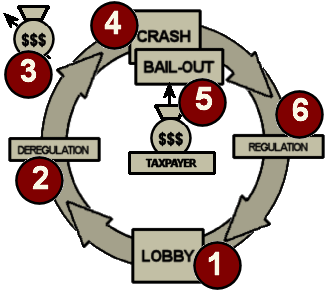
-
Lobby: During the New Deal, the Savings and Loans were limited in the services they could provide and regulated in terms of the fraction of their assets they could loan out. They mounted a strong lobby to be allowed more latitude.
-
Deregulation: In 1982, the Reagan Administration passed the Garn-St. Germain Depository Institutions Act allowing them to lend up to 90% of their assets, increase their Banking services, while leaving them outside the regulatory oversight of regular Banks.
-
Boom: They proliferated like crazy, and they made a killing.
-
Crash: When their shaky loans and mortgages began to fail, they crashed.
-
Bailout: The Federal Bailout program laid out $160,000,000,000, of which $40,000,000,000 was never retrieved.
-
Regulation: In 1989, Congress enacted the Financial Institutions Reform, Recovery and Enforcement Act that created a number of agencies specifically designed to regulate the "Thrifts" and increased the Fannie May and Freddy Mac involvement in the small mortgage market.
-
Lobby: The lobbying came from not only the entire financial sector, but also from a specific company – Enron – a trader in energy resources.
-
Deregulation: The Commodity Futures Modernization Act of 2000 was the second of Senator Phil Gramm’s Bills, the net of the two being the repeal of the Glass-Steagall Act of the 1930’s. In essence, Bank issued Commodities [Derivatives] were both allowed and unregulated, traded outside the Stock Exchanges. A kicker was to unregulate energy trading [the "Enron loophole"]. Prior to this, Banks making loans held the risk of the loan – meaning that there was a strong incentive to make "good loans." Gramm’s Bill allowed Banks to sell the loans and the risk, so the incentive was to make more loans, sell them, then reloan the money.
-
Boom: Since the Bank no longer held the risk, they made shakier and shakier loans to shaky people, using delayed payment as an incentive. Housing prices soared and there was again, a killing being made in Real Estate.
-
Crash: The "bubble burst" when people [predictably] began defaulting on the loans. The institutions who had made money on the "derivitives" were left holding worthless paper making them insolvent.
-
Bailout: Now we have a Stock Market Crash with a bailout escalating to unimaginable levels, and, at the least, a national Recession.
-
Regulation: Coming soon to a Congress in your neighborhood.
So, what is the lesson? What we’ve learned is something we already knew. The Free Market Economy is not self regulating. I’ll say it again. The Free Market Economy is not self regulating. In retrospect, the New Deal Regulations of the Glass-Steagall Act were brilliant. They were focused on limiting the size of Banks, controlling loan practices and interest rates, and eliminating conflicting services in Banks and Investment Companies. All three pieces were essential. The Security and Exchange Commission was equally brilliant. It required transparency in the accounting of publicly traded companies and enforced honesty in trading.
|
These debacles deregulated the Banking/Investment Industry and evaded Oversight – both with disasterous results.
|
So, instead of bailing out these huge Banks, we probably need to go back to the wisdom of small Banks, clearly defined, with strict regulations. In my opinion, all trading on any Market should be regulated and overseen, as is true of the S.E.C. for the Stock Market.
|
If we are to insure savings, we must regulate savings accounts. If we are going to bail out bad loans, we must regulate the loaning of money. If we are to publicly own companies, we should be involved in the regulation of how they use our money, no matter where it is traded. If we the people are going to back these things up, we should be intimately involved in the oversight of their functioning.
|
And about Lobbying. I don’t know how one deals with that. But it’s a cancer on the country. Lobbyists simply have too much power over our elected officials.
And, we need an E.O.A.. What’s an E.O.A.? The Economy Oversight Agency. The Housing Bubble and the out of control Derivative Markets may have been known to some academic economists and government officials, but the guy on the street didn’t expect September 16th, 2008. The S&L Crisis was the same way – unknown until it happened [helped along by the Keating Five]. If the big guys knew about it, they did nothing to stop it or slow it down. We need an Agency charged with constantly looking at our economy and letting us know where we stand. This business of Crisis Management can only be stopped by early detection and prompt intervention. Letting nature take its course is killing us.
[…] looking back – the Deregulation II… The traders are incentivized to extract money from the system for themselves. It’s absurd. Commercial Banks only make money by loaning money and charging for services. That means they keep money in play. Investment Banks make money by "playing the market" – by taking money "out of play." It’s an insane system. We need nothing short of a modernized Glass-Steagall Act. It’s that simple. Reagan’s revolution of deregulation was a smokescreen for the Wall Street profiteers and they’ve had their way with us ever since… […]